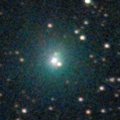
|
Now it is bright as 11.3 mag (Aug. 4, Maik Meyer). It is expected to brighten up to 8 mag in autumn. In the Northern Hemisphere, it stays observable for a long time while the comet is brightening. In the Southern Hemisphere, it it not observable until mid September.
Date(TT) R.A. (2000) Decl. Delta r Elong. m1 Best Time(A, h)
Aug. 3 4 24.75 58 52.0 1.702 1.532 62 10.7 3:33 (219, 44)
Aug. 10 4 17.41 58 26.6 1.537 1.504 68 10.4 3:41 (219, 49)
|
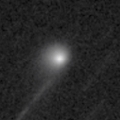
|
Now it is 11.7 mag (Aug. 5, Juan Jose Gonzalez). It will brighten up to 10.5 mag and it will be observable in good condition from autumn to winter.
Date(TT) R.A. (2000) Decl. Delta r Elong. m1 Best Time(A, h)
Aug. 3 2 43.43 15 45.7 3.166 3.271 86 11.7 3:33 (291, 52)
Aug. 10 2 43.08 17 30.7 3.036 3.252 93 11.5 3:41 (298, 60)
|

|
It has not been observed yet in this apparition. Now it is fainter than 21.5 mag (Aug. 4, Erwin Schwab). It was expected to brighten up to 12 mag from August to September. But actually, it must be much fainter than expected. It is observable in good condition in the Northern Hemisphere. In the Southern Hemisphere, it will be getting lower after this, and it will be unobservable in September.
Date(TT) R.A. (2000) Decl. Delta r Elong. m1 Best Time(A, h)
Aug. 3 3 22.24 24 15.4 1.187 1.359 75 12.6 3:33 (272, 49)
Aug. 10 3 43.72 27 56.4 1.164 1.360 76 12.3 3:41 (269, 53)
|

|
It brightened rapidly. Now it is very bright as 12.7 mag (Aug. 5, Hidetaka Sato). It stays at 12.5 mag until September. In the Southern Hemisphere, it stays observable in the low sky until it becomes fainter than 18 mag in winter. It is not observable at all in the Northern Hemisphere.
Date(TT) R.A. (2000) Decl. Delta r Elong. m1 Best Time(A, h)
Aug. 3 7 44.54 -17 28.5 2.073 1.430 38 12.7 3:33 (273,-27)
Aug. 10 8 1.51 -22 15.5 2.019 1.441 42 12.7 3:41 (280,-26)
|
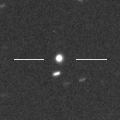
|
Now it is 13.3 mag (July 30, Ken-ichi Kadota). It is expected to brighten up to 7 mag in 2020.
Date(TT) R.A. (2000) Decl. Delta r Elong. m1 Best Time(A, h)
Aug. 3 4 56.11 19 14.2 4.199 3.716 55 12.9 3:33 (265, 27)
Aug. 10 5 2.18 20 0.9 4.041 3.650 60 12.7 3:41 (268, 34)
|

|
Now it is 13.9 mag (Aug. 2, Charles S. Morris). It will brighten rapidly up to 11.5 mag in autumn. In the Northern Hemisphere, it will be observable in excellent condition. In the Southern Hemisphere, it will be extremely low from autumn to winter.
Date(TT) R.A. (2000) Decl. Delta r Elong. m1 Best Time(A, h)
Aug. 3 1 24.90 4 17.1 0.797 1.479 108 13.2 3:33 (329, 56)
Aug. 10 1 38.90 8 2.0 0.747 1.459 110 12.8 3:41 (336, 61)
|
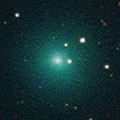
|
It brightened rapidly up to 10 mag in June. Now it is not observable. It will appear in the morning sky in October. But it will be fainter than 18 mag at that time.
Date(TT) R.A. (2000) Decl. Delta r Elong. m1 Best Time(A, h)
Aug. 3 9 22.47 26 56.4 2.522 1.543 11 13.2 20:38 (129, -6)
Aug. 10 9 34.64 23 27.1 2.595 1.600 8 13.7 20:28 (127,-10)
|
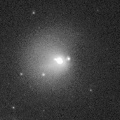
|
Now it is 14.4 mag (Aug. 3, Chris Wyatt). Richard Miles reported that it brightened by 2 mag in outburst on Aug. 2.
Date(TT) R.A. (2000) Decl. Delta r Elong. m1 Best Time(A, h)
Aug. 3 1 1.16 15 51.5 5.349 5.771 109 13.4 3:33 (330, 69)
Aug. 10 1 0.93 16 3.8 5.251 5.771 116 13.3 3:41 (354, 71)
|

|
Appearing in the morning sky. It is observable at 14 mag in good condition in autumn.
Date(TT) R.A. (2000) Decl. Delta r Elong. m1 Best Time(A, h)
Aug. 3 6 53.13 18 56.1 3.089 2.242 27 13.5 3:33 (249, 4)
Aug. 10 7 7.68 18 25.4 3.074 2.266 31 13.5 3:41 (253, 7)
|

|
Now it is 14.2 mag (Aug. 3, Chris Wyatt). It stays 13-14 mag for a long time in 2019. In the Southern Hemisphere, it is observable in excellent condition. In the Northern Hemisphere, it is not observasble until summer in 2020.
Date(TT) R.A. (2000) Decl. Delta r Elong. m1 Best Time(A, h)
Aug. 3 8 19.59 -59 2.2 3.085 3.023 76 13.9 3:33 (321,-45)
Aug. 10 8 28.40 -60 51.3 3.084 3.027 77 13.9 3:41 (324,-41)
|
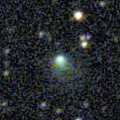
|
Now it is 13.8 mag (Aug. 3, Chris Wyatt). It will be observable at 13.5 mag in good condition in autumn.
Date(TT) R.A. (2000) Decl. Delta r Elong. m1 Best Time(A, h)
Aug. 3 17 13.76 -5 43.5 1.280 2.047 125 14.1 20:38 ( 4, 49)
Aug. 10 17 15.74 -6 37.8 1.304 2.015 120 14.1 20:28 ( 10, 48)
|

|
It brightened up to 7.7 mag in June in 2018 (June 19, Juan Jose Gonzalez). Now it is fading. It has already faded down to 15.0 mag (Aug. 3, Chris Wyatt). In the Southern Hemisphere, it stays observable for a long time until the comet will fade out. In the Northern Hemisphere, it is not observable for a long time until autumn when the comet fades out down to 16 mag.
Date(TT) R.A. (2000) Decl. Delta r Elong. m1 Best Time(A, h)
Aug. 3 6 43.15 -28 33.8 4.893 4.399 55 14.1 3:33 (291,-21)
Aug. 10 6 47.73 -28 39.4 4.922 4.457 57 14.2 3:41 (295,-15)
|
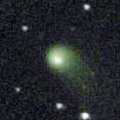
|
Now it is 14.3 mag (July 23, Chris Wyatt). It will be fading slowly after this. It is observable in excellent condition in the Southern Hemisphere. It will never be observable after this in the Northern Hemisphere.
Date(TT) R.A. (2000) Decl. Delta r Elong. m1 Best Time(A, h)
Aug. 3 13 36.26 -42 26.1 3.622 3.744 88 14.5 20:38 ( 38, -3)
Aug. 10 13 34.51 -42 31.5 3.765 3.776 82 14.6 20:28 ( 41, -6)
|
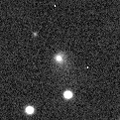
|
Now it is 14.2 mag (Aug. 3, Chris Wyatt). In the Southern Hemisphere, it is observable for a long time. It stays low in the Northern Hemisphere.
Date(TT) R.A. (2000) Decl. Delta r Elong. m1 Best Time(A, h)
Aug. 3 0 17.53 -45 56.9 3.511 4.223 128 14.7 3:33 ( 0, 9)
Aug. 10 0 11.59 -46 4.0 3.491 4.246 132 14.7 3:01 ( 0, 9)
|
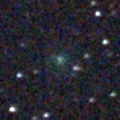
|
It brightened rapidly up to 11.2 mag from May to June (May 28, Chris Wyatt). Now it is fading. But it is still bright as 13.9 mag (July 23, Chris Wyatt). In the Southern Hemisphere, it stays observable in the evening sky for a long time after this while the comet will be fading. It is not observable at all in the Northern Hemisphere.
Date(TT) R.A. (2000) Decl. Delta r Elong. m1 Best Time(A, h)
Aug. 3 10 48.43 -39 9.9 1.994 1.784 63 15.0 20:38 ( 59,-27)
Aug. 10 11 18.50 -38 19.5 2.107 1.845 61 15.6 20:28 ( 59,-25)
|
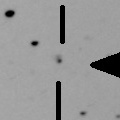
|
Asteroid, but it brightened rapidly. Now it is 16.3 mag (May 24, ATLAS-MLO, Mauna Loa). It is observable in excellent condition in the Southern Hemisphere. In the Northern Hemisphere, it locates extremely low for a while.
Date(TT) R.A. (2000) Decl. Delta r Elong. m1 Best Time(A, h)
Aug. 3 21 11.35 -42 59.7 5.493 6.423 154 15.9 0:29 ( 0, 12)
Aug. 10 21 1.13 -43 9.5 5.505 6.421 152 15.9 23:46 ( 0, 12)
|
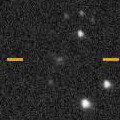
|
Now it is 16.6 mag (May 10, Mount John Observatory, Lake Tekapo). It stays 16 mag for a long time from 2019 to 2020. It is observable in excellent condition in the Southern Hemisphere. It is hardly observable in the Northern Hemisphere.
Date(TT) R.A. (2000) Decl. Delta r Elong. m1 Best Time(A, h)
Aug. 3 10 59.16 -53 39.3 3.722 3.623 76 15.9 20:38 ( 43,-31)
Aug. 10 11 2.81 -54 6.1 3.759 3.603 73 15.9 20:28 ( 43,-33)
|

|
Now it is 16.2 mag (Aug. 6, Hirohisa Sato). It is observable at 16 mag in good condition from summer to autumn. It locates somewhat low in the Southern Hemisphere.
Date(TT) R.A. (2000) Decl. Delta r Elong. m1 Best Time(A, h)
Aug. 3 2 47.82 23 1.8 1.890 2.045 83 16.0 3:33 (280, 55)
Aug. 10 2 58.97 24 5.1 1.830 2.055 87 16.0 3:41 (283, 61)
|
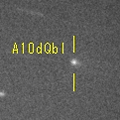
|
Now it is 15.6 mag (Aug. 3, Chris Wyatt). It stays observable in good condition while the comet will be fading slowly after this.
Date(TT) R.A. (2000) Decl. Delta r Elong. m1 Best Time(A, h)
Aug. 3 2 35.97 10 45.9 1.832 2.095 90 16.0 3:33 (299, 50)
Aug. 10 2 47.51 10 30.9 1.786 2.117 94 16.0 3:41 (306, 54)
|
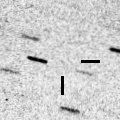
|
Peculiar asteroid moving along a cometary orbit. Now it is 17.5 mag (Aug. 1, Katsumi Yoshimoto). It will approach to Earth down to 0.37 a.u. in mid August. Then it will brighten up to 15 mag and will be observable in good condition.
Date(TT) R.A. (2000) Decl. Delta r Elong. m1 Best Time(A, h)
Aug. 3 1 20.45 -7 7.7 0.699 1.444 113 17.1 3:33 (337, 45)
Aug. 10 0 24.84 -14 56.9 0.497 1.409 134 16.0 3:16 ( 0, 41)
|

|
It approached to Earth down to 0.3 a.u. in mid February, and brightened up to 5.5 mag (Feb. 13, Juan Jose Gonzalez). Now it is fading. It has already faded down to 16.6 mag (Aug. 2, Ken-ichi Kadota).
Date(TT) R.A. (2000) Decl. Delta r Elong. m1 Best Time(A, h)
Aug. 3 4 42.26 39 21.1 3.152 2.742 57 16.1 3:33 (244, 38)
Aug. 10 4 38.97 40 0.5 3.102 2.816 64 16.2 3:41 (246, 45)
|
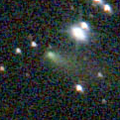
|
Now it is 16.8 mag (Aug. 2, Ken Ogawa). It is observable in excellent condition in the Northern Hemisphere. It locates extremely low in the Southern Hemisphere. It will be fading after this, and it will be fainter than 18 mag in late September.
Date(TT) R.A. (2000) Decl. Delta r Elong. m1 Best Time(A, h)
Aug. 3 1 1.77 46 27.2 1.563 1.929 94 16.2 3:33 (213, 76)
Aug. 10 1 7.31 46 49.3 1.554 1.983 98 16.4 3:41 (192, 78)
|
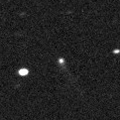
|
Now it is 16.6 mag (July 1, D. T. Durig). It stays 15-16 mag for a long time until 2021.
Date(TT) R.A. (2000) Decl. Delta r Elong. m1 Best Time(A, h)
Aug. 3 21 22.39 -34 50.0 4.185 5.158 161 16.2 0:40 ( 0, 20)
Aug. 10 21 12.35 -34 32.1 4.160 5.130 161 16.2 0:02 ( 0, 21)
|
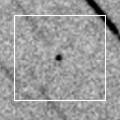
|
It passed the perihelion on July 2. Then it must have brightened up to 13 mag, but it was not observable around that time. In the Northern Hemisphere, it will appear in the morning sky at 16 mag in late July. In the Southern Hemisphere, it will be too low to observe.
Date(TT) R.A. (2000) Decl. Delta r Elong. m1 Best Time(A, h)
Aug. 3 5 16.11 42 10.6 0.974 0.864 51 16.3 3:33 (238, 33)
Aug. 10 5 10.35 44 0.4 0.997 0.988 58 16.5 3:41 (239, 41)
|

|
Now it is 14.2 mag (May 7, Thomas Lehmann). It will be fading after this. In the Southern Hemisphere, it stays observable for a long time until it fades out. In the Northern Hemisphere, it will not be observable after this.
Date(TT) R.A. (2000) Decl. Delta r Elong. m1 Best Time(A, h)
Aug. 3 6 33.45 -28 22.7 5.093 4.615 56 16.3 3:33 (292,-19)
Aug. 10 6 36.64 -29 42.3 5.095 4.667 59 16.4 3:41 (297,-14)
|
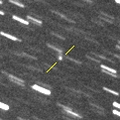
|
Now it is 16.1 mag (June 5, Toshihiko Ikemura, Hirohisa Sato). It will brighten up to 14 mag in winter. It stays observable for a long time in the Southern Hemisphere. It is observable only until early August in the Northern Hemisphere.
Date(TT) R.A. (2000) Decl. Delta r Elong. m1 Best Time(A, h)
Aug. 3 15 7.54 -35 45.6 2.617 3.022 103 16.4 20:38 ( 28, 12)
Aug. 10 15 1.72 -36 26.1 2.678 2.965 96 16.4 20:28 ( 32, 9)
|
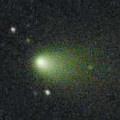
|
It brightened up to 12-13 mag from winter to spring. Now it is fading. It has already faded down to 15.1 mag (June 5, Thomas Lehmann). It will be getting lower after this. It will be unobservable in August in the Northern Hemisphere, or in September in the Southern Hemisphere.
Date(TT) R.A. (2000) Decl. Delta r Elong. m1 Best Time(A, h)
Aug. 3 12 43.61 -0 36.3 2.872 2.526 60 16.4 20:38 ( 77, 16)
Aug. 10 12 53.58 -2 12.0 2.970 2.553 56 16.6 20:28 ( 77, 13)
|

|
It has not been observed yet in this apparition. It will brighten up to 15.5 mag and it will be observable in good condition in autumn.
Date(TT) R.A. (2000) Decl. Delta r Elong. m1 Best Time(A, h)
Aug. 3 0 4.57 -5 5.9 1.950 2.725 130 16.7 3:21 ( 0, 50)
Aug. 10 0 5.86 -5 20.1 1.862 2.696 137 16.5 2:55 ( 0, 50)
|
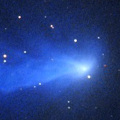
|
Now it is 16.1 mag (June 5, Toshihiko Ikemura, Hirohisa Sato). It will be fading slowly after this. It is observable in good condition in the Northern Hemisphere. In the Southern Hemisphere, it stays extremely low for a while.
Date(TT) R.A. (2000) Decl. Delta r Elong. m1 Best Time(A, h)
Aug. 3 14 43.18 31 53.6 5.214 5.123 79 16.6 20:38 ( 96, 56)
Aug. 10 14 45.26 30 27.2 5.338 5.176 75 16.7 20:28 ( 96, 53)
|
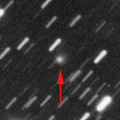
|
Now it is 16.7 mag (June 27, Thomas Lehmann). It is expected to be observable at 5-6 mag for a long time from 2022 to 2023. In the Northern Hemisphere, it is not observable at the highlight from 2022 summer to 2023 summer. In the Southern Hemisphere, it stays unobservable for a while. But it will be observable in good condition at the highlight.
Date(TT) R.A. (2000) Decl. Delta r Elong. m1 Best Time(A, h)
Aug. 3 17 14.69 56 29.1 11.044 11.148 93 16.7 20:38 (176, 69)
Aug. 10 17 12.12 55 54.2 11.020 11.101 91 16.7 20:28 (168, 68)
|
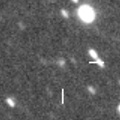
|
Now it is 17.2 mag (May 26, iTelescope Observatory, Siding Spring). It will be fading slowly after this. It is observable in excellent condition in the Southern Hemisphere. It locates low in the Northern Hemisphere.
Date(TT) R.A. (2000) Decl. Delta r Elong. m1 Best Time(A, h)
Aug. 3 14 48.59 -39 31.3 3.315 3.644 100 16.7 20:38 ( 29, 7)
Aug. 10 14 41.19 -39 5.7 3.440 3.639 93 16.8 20:28 ( 34, 5)
|

|
First return of a new periodic comet which brightened up to 16.5 mag in 2009. It has not been recovered yet in this apparition. It will brighten up to 16 mag in autumn. It is observable in good condition in the Northern Hemisphere. It locates low in the Southern Hemisphere.
Date(TT) R.A. (2000) Decl. Delta r Elong. m1 Best Time(A, h)
Aug. 3 4 28.31 27 56.5 1.537 1.363 60 17.0 3:33 (259, 37)
Aug. 10 4 58.48 28 18.9 1.497 1.333 60 16.7 3:41 (259, 38)
|
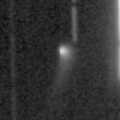
|
Now it is 16.7 mag (May 2, Kunihiro Shima). It will be fading after this. In the Northern Hemisphere, it stays observable in good condition for a long time. In the Southern Hemisphere, it stays extremely low for a long time.
Date(TT) R.A. (2000) Decl. Delta r Elong. m1 Best Time(A, h)
Aug. 3 4 22.47 49 5.5 4.156 3.782 61 16.9 3:33 (233, 44)
Aug. 10 4 20.04 49 18.0 4.079 3.815 67 16.9 3:41 (233, 50)
|
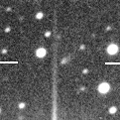
|
Now it is 17.5 mag (Aug. 2, Ken Ogawa). It will be observable at 17 mag in good condition from August to September.
Date(TT) R.A. (2000) Decl. Delta r Elong. m1 Best Time(A, h)
Aug. 3 1 26.42 34 57.6 1.986 2.324 96 17.2 3:33 (264, 76)
Aug. 10 1 19.65 32 36.8 1.874 2.343 104 17.1 3:41 (289, 84)
|

|
It has not been observed yet in this apparition. It will brighten up to 16 mag in autumn. It is observable in good condition in the Southern Hemisphere. It locates somewhat low in the Northern Hemisphere.
Date(TT) R.A. (2000) Decl. Delta r Elong. m1 Best Time(A, h)
Aug. 3 18 28.70 -41 46.2 1.208 2.099 141 17.7 21:42 ( 0, 13)
Aug. 10 18 25.35 -40 23.8 1.219 2.068 135 17.5 21:11 ( 0, 15)
|

|
It has not been observed yet in this apparition. It was expected to be observable at 17.5 mag from June to August. But actually, it was fainter than 21.5 mag in March (Mar. 10, Erwin Schwab).
Date(TT) R.A. (2000) Decl. Delta r Elong. m1 Best Time(A, h)
Aug. 3 18 31.04 -17 45.1 1.167 2.092 146 17.5 21:44 ( 0, 37)
Aug. 10 18 30.76 -18 60.0 1.207 2.090 140 17.6 21:17 ( 0, 36)
|
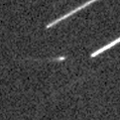
|
Now it is 16.9 mag (May 29, Toshihiko Ikemura, Hirohisa Sato). It brightened up to 17 mag in July, but it will be fainter than 18 mag soon. It is observable in good condition in the Southern Hemisphere. It locates low in the Northern Hemisphere.
Date(TT) R.A. (2000) Decl. Delta r Elong. m1 Best Time(A, h)
Aug. 3 13 39.21 -28 57.9 0.761 1.201 83 17.6 20:38 ( 46, 7)
Aug. 10 14 12.07 -34 14.4 0.818 1.258 85 17.8 20:28 ( 41, 5)
|

|
Now it is 16.4 mag (May 26, Toshihiko Ikemura, Hirohisa Sato). It is observable at 17 mag in good condition in 2019. It locates somewhat low in the Northern Hemisphere.
Date(TT) R.A. (2000) Decl. Delta r Elong. m1 Best Time(A, h)
Aug. 3 15 14.33 -16 27.8 3.660 3.972 100 17.6 20:38 ( 36, 30)
Aug. 10 15 17.07 -16 47.5 3.771 3.980 94 17.7 20:28 ( 40, 28)
|
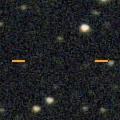
|
It will brighten up to 17.5 mag, and it will be observable in good condition in autumn.
Date(TT) R.A. (2000) Decl. Delta r Elong. m1 Best Time(A, h)
Aug. 3 1 30.28 19 45.3 2.937 3.297 101 17.9 3:33 (308, 68)
Aug. 10 1 33.29 20 7.0 2.847 3.298 107 17.8 3:41 (326, 73)
|
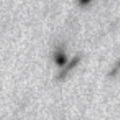
|
Now it is 17.3 mag (May 26, iTelescope Observatory, Siding Spring). In the Southern Hemisphere, it is observable at 17.5 mag in good condition from spring to summer. In the Northern Hemisphere, it is not observable at all.
Date(TT) R.A. (2000) Decl. Delta r Elong. m1 Best Time(A, h)
Aug. 3 16 13.55 -51 30.3 3.847 4.397 116 17.9 20:38 ( 11, 2)
Aug. 10 16 15.12 -50 40.7 3.928 4.398 111 17.9 20:28 ( 14, 2)
|

|
In the Southern Hemisphere, it is observable at 18 mag in good condition from July to August. It locates low in the Northern Hemisphere.
Date(TT) R.A. (2000) Decl. Delta r Elong. m1 Best Time(A, h)
Aug. 3 20 15.27 -33 23.6 2.646 3.627 162 17.9 23:28 ( 0, 22)
Aug. 10 20 10.56 -33 35.8 2.671 3.624 156 17.9 22:56 ( 0, 21)
|

|
Now it is fading. In 2019, it is observable at 17.5 mag in good condition in autumn.
Date(TT) R.A. (2000) Decl. Delta r Elong. m1 Best Time(A, h)
Aug. 3 2 49.54 10 52.0 3.951 4.026 86 17.9 3:33 (295, 48)
Aug. 10 2 52.43 11 3.4 3.861 4.040 92 17.9 3:41 (304, 54)
|

|
It will brighten up to 16.5 mag in winter, and it will be observable in good condition. It locates somewhat low in the Southern Hemisphere.
Date(TT) R.A. (2000) Decl. Delta r Elong. m1 Best Time(A, h)
Aug. 3 3 52.08 22 47.8 3.619 3.397 69 18.0 3:33 (270, 42)
Aug. 10 3 59.49 23 11.8 3.515 3.385 74 17.9 3:41 (273, 48)
|

|
First return of a new periodic comet which brightened up to 17 mag in 2006. It has not been recovered yet in this apparition. It will brighten up to 18 mag in autumn. It is observable in good condition in the Southern Hemisphere. It locates extremely low in the Northern Hemisphere.
Date(TT) R.A. (2000) Decl. Delta r Elong. m1 Best Time(A, h)
Aug. 3 16 20.72 -38 43.9 2.002 2.641 118 17.9 20:38 ( 13, 15)
Aug. 10 16 24.60 -38 16.1 2.053 2.618 112 17.9 20:28 ( 16, 15)
|
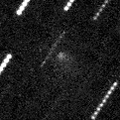
|
It was bright as 16.3 mag in May (May 23, Ken-ichi Kadota). However, it is getting diffused and fading very rapidly in July. The nucleus may be disintegrated. It is observable in excellent condition in the Northern Hemisphere. It is not observable in the Southern Hemisphere.
Date(TT) R.A. (2000) Decl. Delta r Elong. m1 Best Time(A, h)
Aug. 3 13 50.01 55 23.6 1.861 1.737 66 19.3 20:38 (136, 48)
Aug. 10 13 50.17 48 30.5 1.940 1.749 63 19.9 20:28 (125, 46)
|
|
![]()
 C/2019 A9 ( PanSTARRS )
C/2019 A9 ( PanSTARRS ) C/2017 T2 ( PanSTARRS )
C/2017 T2 ( PanSTARRS ) 260P/McNaught
260P/McNaught C/2018 R3 ( Lemmon )
C/2018 R3 ( Lemmon ) 29P/Schwassmann-Wachmann 1
29P/Schwassmann-Wachmann 1 78P/Gehrels 2
78P/Gehrels 2 C/2018 A6 ( Gibbs )
C/2018 A6 ( Gibbs ) 68P/Klemola
68P/Klemola C/2016 M1 ( PanSTARRS )
C/2016 M1 ( PanSTARRS ) C/2017 M4 ( ATLAS )
C/2017 M4 ( ATLAS ) C/2017 B3 ( LINEAR )
C/2017 B3 ( LINEAR ) C/2018 W1 ( Catalina )
C/2018 W1 ( Catalina ) A/2017 U7
A/2017 U7 C/2018 F4 ( PanSTARRS )
C/2018 F4 ( PanSTARRS ) 261P/Larson
261P/Larson C/2019 K5 ( Young )
C/2019 K5 ( Young ) A/2018 V3
A/2018 V3 C/2018 Y1 ( Iwamoto )
C/2018 Y1 ( Iwamoto ) C/2019 D1 ( Flewelling )
C/2019 D1 ( Flewelling ) C/2019 K7 ( Smith )
C/2019 K7 ( Smith ) (3200) Phaethon
(3200) Phaethon C/2016 N6 ( PanSTARRS )
C/2016 N6 ( PanSTARRS ) C/2019 K1 ( ATLAS )
C/2019 K1 ( ATLAS ) 123P/West-Hartley
123P/West-Hartley 101P/Chernykh
101P/Chernykh C/2016 R2 ( PanSTARRS )
C/2016 R2 ( PanSTARRS ) C/2017 K2 ( PanSTARRS )
C/2017 K2 ( PanSTARRS ) C/2018 KJ3 ( Lemmon )
C/2018 KJ3 ( Lemmon ) P/2008 Y1 ( Boattini )
P/2008 Y1 ( Boattini ) C/2018 A3 ( ATLAS )
C/2018 A3 ( ATLAS ) C/2019 K4 ( Ye )
C/2019 K4 ( Ye ) 160P/LINEAR
160P/LINEAR P/2012 K3 ( Gibbs )
P/2012 K3 ( Gibbs ) 209P/LINEAR
209P/LINEAR 74P/Smirnova-Chernykh
74P/Smirnova-Chernykh 200P/Larsen
200P/Larsen 186P/Garradd
186P/Garradd 215P/NEAT
215P/NEAT 65P/Gunn
65P/Gunn 203P/Korlevic
203P/Korlevic P/2006 H1 ( McNaught )
P/2006 H1 ( McNaught ) C/2019 J2 ( Palomar )
C/2019 J2 ( Palomar )![]()

































